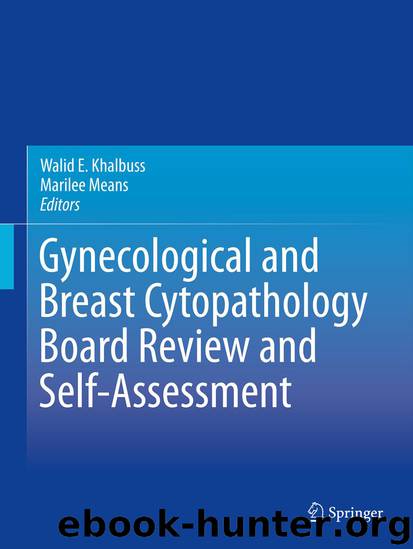Gynecological and Breast Cytopathology Board Review and Self-Assessment by Walid E. Khalbuss & Marilee Means

Author:Walid E. Khalbuss & Marilee Means
Language: eng
Format: epub
Publisher: Springer New York, New York, NY
A-43.(c) Squamous cell carcinoma
This is a case of invasive squamous cell carcinoma (SCC). Squamous cell carcinoma comes in two morphologic variants, keratinizing and nonkeratinizing. The Bethesda System (TBS) does not subdivide squamous cell carcinoma into these categories, but the cytomorphologic features are somewhat different. Nonkeratinizing variant shows cells with immature cytoplasm, high nuclear/cytoplasmic ratios, and nuclei with prominent nucleoli, irregular chromatin distribution, and irregular nuclear membranes. These cells may be seen in loose or syncytial groups or as single cells. Associated features may include a tumor diathesis composed of necrotic debris, old blood, and inflammation in conventional smear or clinging necrosis in liquid-based preparations. Keratinizing SCC displays all of the cellular characteristics of keratinizing HSIL with the addition of variable numbers of cells demonstrating nucleoli or the addition of a tumor diathesis. Features include marked cellular variation with tadpole, spindle, and caudate shapes (more seen in left image), dense eosinophilic cytoplasm, and markedly hyperchromatic, often opaque nuclei with high N/C ratios. Cells may be single or in loose or even thick groups.
The presence of a tumor diathesis suggests an invasive carcinoma. This finding is still noted on liquid samples but may be somewhat patchy.
Download
This site does not store any files on its server. We only index and link to content provided by other sites. Please contact the content providers to delete copyright contents if any and email us, we'll remove relevant links or contents immediately.
Periodization Training for Sports by Tudor Bompa(8170)
Why We Sleep: Unlocking the Power of Sleep and Dreams by Matthew Walker(6618)
Paper Towns by Green John(5091)
The Immortal Life of Henrietta Lacks by Rebecca Skloot(4525)
The Sports Rules Book by Human Kinetics(4294)
Dynamic Alignment Through Imagery by Eric Franklin(4118)
ACSM's Complete Guide to Fitness & Health by ACSM(3989)
Kaplan MCAT Organic Chemistry Review: Created for MCAT 2015 (Kaplan Test Prep) by Kaplan(3940)
Introduction to Kinesiology by Shirl J. Hoffman(3726)
Livewired by David Eagleman(3684)
The Death of the Heart by Elizabeth Bowen(3552)
The River of Consciousness by Oliver Sacks(3541)
Alchemy and Alchemists by C. J. S. Thompson(3451)
Bad Pharma by Ben Goldacre(3357)
Descartes' Error by Antonio Damasio(3230)
The Emperor of All Maladies: A Biography of Cancer by Siddhartha Mukherjee(3066)
The Gene: An Intimate History by Siddhartha Mukherjee(3047)
The Fate of Rome: Climate, Disease, and the End of an Empire (The Princeton History of the Ancient World) by Kyle Harper(3003)
Kaplan MCAT Behavioral Sciences Review: Created for MCAT 2015 (Kaplan Test Prep) by Kaplan(2940)
